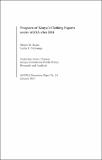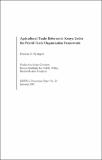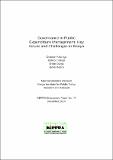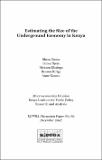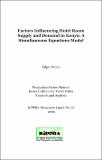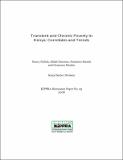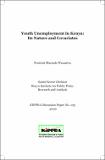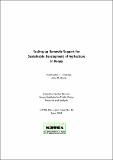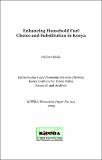Search
Now showing items 1-10 of 12
Discussion Paper No. 24 of 2003 on Prospects of Kenya's Clothing Exports under AGOA after 2004
(The Kenya Institute for Public Policy Research and Analysis (KIPPRA), 2003)
After unprecedented decline in Kenya’s cotton-textile-apparel industry since
the early 1990s, substantial interest in its revival has emerged. This interest
has largely been stimulated by the market opportunity presented ...
Discussion Paper No. 25 of 2003 on Agricultural Trade Reforms in Kenya Under the World Trade Organization Framework
(The Kenya Institute for Public Policy Research and Analysis (KIPPRA), 2003)
The agricultural sector in Kenya has shown mixed performance with the onset
of liberalization of the Kenyan economy. Under liberalization policies of the
structural adjustment programs (SAPS), agricultural monopolies ...
Discussion Paper No. 77 of 2007 on Governance in Public Expenditure Management: Key Issues and Challenges in Kenya
(The Kenya Institute for Public Policy Research and Analysis (KIPPRA), 2007)
This paper develops a conceptual framework for applying good governance to systems of public expenditure management (PEM), and analyses governance in public expenditure management in Kenya. An overview of some key governance ...
Discussion Paper No. 82 of 2007 on Estimating the Size of the Underground Economy in Kenya
(The Kenya Institute for Public Policy Research and Analysis (KIPPRA), 2007)
The underground economy comprises economic activities not accounted for in national income statistics and is, therefore, difficult to measure. The difficulty arises because this economy comprises a host of traditional and ...
Discussion Paper No. 97 of 2009 on Factors Influencing Hotel Room Supply and Demand in Kenya: a Simultaneous Equations Model
(The Kenya Institute for Public Policy Research and Analysis (KIPPRA), 2009)
Accommodation is a key component of the tourism industry in Kenya, which has been recognized as a key sector in the economic pillar of the country’s Vision 2030. Therefore, the envisaged growth of the tourism industry in ...
Discussion Paper No. 95 of 2008 on Transient and Chronic Poverty in Kenya: Correlates and Trends
(The Kenya Institute for Public Policy Research and Analysis (KIPPRA), 2008)
The pattern of poverty incidence in Kenya has changed over time, with some households moving in and out of poverty while others or their descendants have remained in poverty for decades. Rural poverty, for instance, increased ...
Discussion Paper No. 103 of 2009 on Youth Unemployment in Kenya: Its Nature and Covariates
(The Kenya Institute for Public Policy Research and Analysis (KIPPRA), 2009)
Unemployment among the youth is one of the major policy concerns of
the Government of Kenya, because it imposes costs on individual youth,
their families and the economy. Aware of this policy concern, this study
uses a ...
Discussion Paper No. 100 of 2009 on Wheat Import Demand and Welfare Effects of Import Controls in Kenya
(The Kenya Institute for Public Policy Research and Analysis (KIPPRA), 2009)
Wheat is the second most important cereal in Kenya after maize and it plays an important role in enhancing food security. Despite this importance, the industry has been facing competition from import of cheap wheat. To ...
Discussion Paper No. 83 of 2008 on Scaling-up Domestic Support for Sustainable Development of Agriculture in Kenya
(The Kenya Institute for Public Policy Research and Analysis (KIPPRA), 2008)
Despite prospects for recovery of the agricultural sector in Kenya, there are a myriad of constraints and challenges. Among these are spiralling prices of key agricultural inputs such as fertilizer and energy, political ...
Discussion Paper No. 102 of 2009 on Enhancing Household Fuel Choice and Substitution in Kenya
(The Kenya Institute for Public Policy Research and Analysis (KIPPRA), 2009)
This study looks at the fuel choice and fuel substitution in Kenya. It
focuses on three issues: it analyzes the factors influencing households’
fuel of choice; it studies the factors influencing woodfuels expenditures;
and, ...

